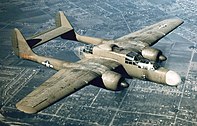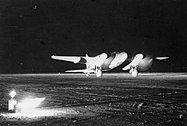
Back مقاتلة ليلية Arabic Gecə qırıcısı Azerbaijani Нощен изтребител Bulgarian Noční stíhací letoun Czech Natjager Danish Nachtjäger German Νυχτερινό μαχητικό Greek Caza nocturno Spanish جنگنده شبانه Persian Yöhävittäjä Finnish
- Top left: Swedish de Havilland Venom NF.51 (J 33), during night operation 1954
- Top right: The nose of a German Lichtenstein radar-equipped Messerschmitt Bf 110 G-4 night fighter
- Bottom left: American Northrop P-61 Black Widow night fighter with a radome nose for its radar
- Bottom right: A de Havilland Mosquito night fighter, with centimetric radar in nose radome
A night fighter (later known as all-weather fighter or all-weather interceptor post-Second World War)[1] is a largely historical term for a fighter or interceptor aircraft adapted or designed for effective use at night, during periods of adverse meteorological conditions, or in otherwise poor visibility. Such designs were in direct contrast to day fighters; fighters and interceptors designed primarily for use during the day or during good weather. The concept of the night fighter was developed and experimented with during the First World War but would not see widespread use until WWII. The term would be supplanted by “all-weather fighter/interceptor” post-WWII, with advancements in various technologies permitting the use of such aircraft in virtually all conditions.
During the Second World War, night fighters were either purpose-built night fighter designs, or more commonly, heavy fighters or light bombers adapted for the mission, often employing radar or other systems for providing some sort of detection capability in low visibility. Many night fighters of the conflict also included instrument landing systems for landing at night, as turning on the runway lights made runways into an easy target for opposing intruders. Some experiments tested the use of day fighters on night missions, but these tended to work only under very favourable circumstances and were not widely successful. The war would see the first aircraft ever that was explicitly designed from the outset to function as a night fighter, the Northrop P-61 Black Widow.
Avionics systems were greatly miniaturised over time, allowing the addition of radar altimeter, terrain-following radar, improved instrument landing system, microwave landing system, Doppler weather radar, LORAN receivers, GEE, TACAN, inertial navigation system, GPS, and GNSS in aircraft. The addition of greatly improved landing and navigation equipment combined with radar led to the use of the term all-weather fighter or all-weather fighter attack, depending on the aircraft capabilities. The use of the term night fighter gradually faded away as a result of these improvements making the vast majority of fighters capable of night operation.
- ^ Winchester 2006, p. 184.



